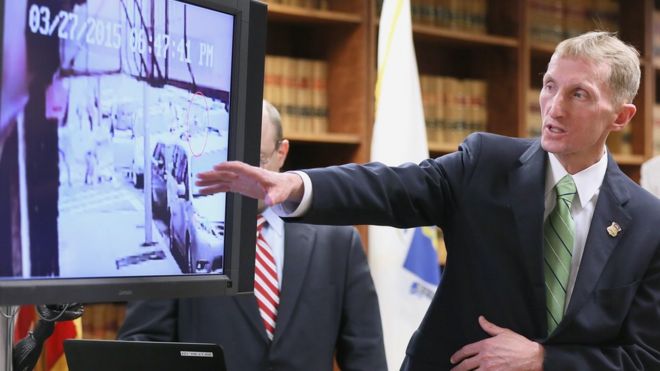- 2 August 2016
- Science & Environment
-
(과학) 슬로모션 재생은 형사책임을 왜곡시킬 수 있다과학과 테크놀로지/과학 2016. 8. 3. 22:59
출처: http://www.bbc.com/news/science-environment-36940475
Slow-motion replays can distort criminal responsibility 슬로모션 재생은 형사책임을 왜곡시킬 수 있다 (criminal responsibility: 형사책임)
 GETTY IMAGES
GETTY IMAGESThe study questions the use of slow-motion replays in court cases Slow-motion video replays of crimes shown in courtrooms may be distorting the outcomes of trials, according to a US study.
Researchers found that slowing down footage of violent acts caused viewers to see greater intent to harm than when viewed at normal speed.
Viewing a killing only in slow motion made a jury three times more likely to convict of first degree murder.
The research has been published in the journal PNAS.
The importance of video evidence in courtrooms has grown in tandem with its supply in recent years.
As well as the mountains of smartphone recordings, CCTV also routinely captures assaults, robberies and even murders. Some police officers even wear on-body cameras.
Courts all over the world are willing to accept these recordings in evidence and they are sometimes shown in slow motion, to help juries make up their minds about what really happened within the often chaotic environment of a crime scene.
Inner intentions
A key point in many murder cases is the intention or otherwise of the accused. So the researchers carried out a number of experiments to determine the impact of slowing down the replay on observers.
In their first study participants, acting as jurors, watched a video recording of an attempted robbery of a store, which ended with the shop assistant being shot dead.
They were shown either a regular speed or a slowed down version. Watching the slow-motion version quadrupled the odds that these mock jurors would begin their deliberations ready to convict.
The researchers believe that the slow motion version is giving observers the sense that those carrying out the violent acts on tape have more time to think and deliberate - and the observers therefore believe there is more intent in the violent actions.
"Slow motion can be a better version of reality, sometimes it's very helpful for seeing how actions unfolded," said lead author Eugene Caruso from the University of Chicago.
"But at the same time we found that it seems to have an effect on our perceptions of someone's inner mental states, and there it's really not so clear that slowing things down gives us a more accurate perception of what was going on in someone's mind at the time they were acting."
 GETTY IMAGES
GETTY IMAGESReferees in sports like rugby can use slow motion replays to determine sanctions against players The team also carried out experiments with the passing time displayed on screen, to see if it made any difference to the perception of intention.
"Telling participants [by displaying the time] is successful in reducing a clear error in how long the actor had," said Prof Caruso.
"It doesn't actually eliminate the subjective feeling or the sense that he really had a lot of time, and those feelings of the amount of time he had to act are really predictive of their intentionality judgments."
He and his colleagues also wanted to test what would happen if participants were shown both real time and slowed versions of the events.
Compared with mock juries that only saw the regular speed recording, the odds of a unanimous first degree murder verdict were 3.42-fold higher with juries that only saw the slow version.
Juries that saw both the slow and the regular speed version were still 1.55 times more likely to agree the first degree murder verdict than those that just saw the normal speed.
Slow motion with deadly consequences
The authors cite the case of John Lewis who was convicted of the first degree murder of a police officer in Philadelphia in 2007, during an armed robbery.
Key to the jury's decision was a slow-motion surveillance video that convinced them Mr Lewis's actions were premeditated rather than reflexive. Lewis was sentenced to death by lethal injection.
The case was appealed on the basis that the slowed down tape created a false impression of pre-meditation. But judges dismissed this as they said the jurors saw both the regular speed and slowed down versions and the slow-motion tape had a digital display of time elapsed.
Lewis remains on death row.
Other researchers agreed that the use of video and the perceptions of jurors need to be carefully studied.
"This analysis of slow motion use in court cases fits into a broader pattern," said Prof Daniel Reisberg, an expert in psychology from Reed College in Oregon, who was not involved with the study.
"Jurors often seem ready to blame someone for things that (in the jurors' view) the accused person could have realised, or could have foreseen, even though the jurors' supposition is wrong - because the person couldn't have realised or foreseen where things would end up."
The authors also look at the issue of slow-motion replays in sports, and found significant bias when referees or umpires had more time to consider a decision - particularly when doling out punishments. According to Prof Caruso, the use of slow-motion should be limited.
"The reality that the referees actually see in real time, I think is fair as the one to use for that judgement."
'과학과 테크놀로지 > 과학' 카테고리의 다른 글
(과학) 지질학자들 인류세의 '골든 스파이크' 탐색하다 (0) 2016.09.02 (과학) 뇌의 '갈증담당 회로'가 입안을 모니터한다 (0) 2016.08.08 (과학) 타이타니움보다 4배 견고한 초강력 물질은 금과 타이타니움의 합금 (0) 2016.07.31 (과학) NASA 탐사선 주노(Juno) 목성 궤도에 진입 (0) 2016.07.08 (과학) 세계최초 복제양 돌리 복제성공 20주년 (0) 2016.07.08